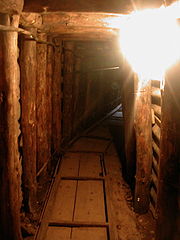
Sarajevo Tunnel
Encyclopedia

Siege of Sarajevo
The Siege of Sarajevo is the longest siege of a capital city in the history of modern warfare. Serb forces of the Republika Srpska and the Yugoslav People's Army besieged Sarajevo, the capital city of Bosnia and Herzegovina, from 5 April 1992 to 29 February 1996 during the Bosnian War.After Bosnia...
during Bosnian War
Bosnian War
The Bosnian War or the War in Bosnia and Herzegovina was an international armed conflict that took place in Bosnia and Herzegovina between April 1992 and December 1995. The war involved several sides...
between 1992 and 1995, the Sarajevo Tunnel was constructed by the besieged citizens of Sarajevo in order to link the city of Sarajevo, which was entirely cut-off by Serbian forces, with the Bosnian-held territory on the other end of the supposedly neutral area at the Sarajevo Airport controlled by the United Nations
United Nations
The United Nations is an international organization whose stated aims are facilitating cooperation in international law, international security, economic development, social progress, human rights, and achievement of world peace...
. The tunnel linked the Sarajevo neighbourhoods of Dobrinja
Dobrinja
Dobrinja is the most populous neighborhood of Sarajevo. It's part of the municipality of Novi Grad. In 1993 a mortar attack was conducted from Serb-held positions on a football game. 13 people died and over 130 were wounded....
and Butmir
Butmir
Butmir is a neighborhood of Ilidža in the Sarajevo Canton of Bosnia and Herzegovina. It is a small but fairly important and well-known neighborhood of several thousand people.Geographically, the Butmir region is very rich in flint...
.
Beginning in January 1993, the Sarajevo Tunnel was dug by Bosnian volunteers working in 8-hour shifts. The Sarajevo tunnel was completed in mid-1993, which allowed food and humanitarian aid
Humanitarian aid
Humanitarian aid is material or logistical assistance provided for humanitarian purposes, typically in response to humanitarian crises including natural disaster and man-made disaster. The primary objective of humanitarian aid is to save lives, alleviate suffering, and maintain human dignity...
to come into the city, and people to get out. The tunnel was one of the major ways of bypassing the international arms embargo
Arms embargo
An arms embargo is an embargo that applies to weaponry. It may also include "dual use" items. An arms embargo may serve one or more purposes:# to signal disapproval of behavior by a certain actor,# to maintain neutral standing in an ongoing conflict, or...
and providing the city defenders with weaponry.
The tunnel was 1.5 metres (4.9 ft) in height and about 1m in width, and ran for approximately 960 metres (3,149.6 ft) in length. During the time it was used, it is estimated that 20 million ton
Ton
The ton is a unit of measure. It has a long history and has acquired a number of meanings and uses over the years. It is used principally as a unit of weight, and as a unit of volume. It can also be used as a measure of energy, for truck classification, or as a colloquial term.It is derived from...
s of food entered the city, and 1 million people passed in and out of it.
The tunnel was most famously used to transport the former Bosnian president Alija Izetbegović
Alija Izetbegovic
Alija Izetbegović was a Bosniak activist, lawyer, author, philosopher and politician, who, in 1990, became the first president of Bosnia and Herzegovina. He served in this role until 1996, when he became a member of the Presidency of Bosnia and Herzegovina, serving until 2000...
in his wheelchair which was run on the railway of the tunnel. The 20 metres (65.6 ft) of tunnel that are left today now form part of a museum in Sarajevo, which is open to visitors every working day from 9 am to 4 pm.
The tunnel was ingeniously dug in a wide L-shape in order to prevent the Serb forces from caving it in with shells, since the tunnel exit points could not remain a secret for too long.
From 1993 to 1995 the tunnel further developed by putting in a mineshaft-like railway, drainage pumps and digging out crossing points where people coming from two different sides could pass by each other as the tunnel was not wide enough to do that everywhere.
It is less known that the Bosnian forces began working on a second, bigger tunnel towards the end of the war, but it was never completed or utilized as the war ended in December of 1995.

